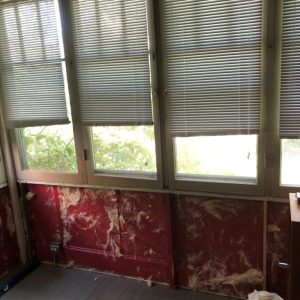Vapor barrier with asbestos siding
I own the bungalow that was discussed in podcast episode #647. I’m renovating a small 6.5’x10′ porch room to make it usable year-round, so insulation will be a top priority. The porch is typical of 1925 Chicago-type bungalows, and it was divided in half and enclosed either when the house was built or shortly thereafter. The half I’m working on has 4 windows that fill one wall and 3 that fill the other. The exterior is clad with what I’m fairly certain is asbestos siding from the 1920’s and there is no room in the budget to remove it. After demoing the bead board and batt insulation the prior owner had installed in the room, as best I can tell the non load-bearing walls appear to be made of some type of particle board. My guess would be there has to be tar paper on the exterior under the siding, but I can’t tell without removing some siding, which I would prefer not to do.
The windows will be removed and replaced with 5 Marvin casement windows. This requires building a standard stud wall to support the new windows and allow for proper insulation. Currently, I’m planning on using unfaced rock wool insulation. There is no evidence of water intrusion or damage on the interior of the particle board walls, so if there is indeed tar paper on the exterior it has worked well for nearly 100 years.
My questions are this:
– is a vapor barrier needed, given the lack of visible water issues?
– should I apply a vapor barrier such as 6mm poly directly onto the particle board, or would that trap moisture and potentially cause the particle board to deteriorate?
– should I use faced insulation batts instead?
– would unfaced rock wool covered with 6mm poly be an alternate choice?
Appreciate any advice.
Thanks,
Larry Kear





















Replies
Hi,
I think you should try to use faced insulation batts for a built in vapor barrier or install unfaced rock wool with 6mm poly on the interior side behind the drywall to prevent moisture issues without risking particle board deterioration.
Thanks
Hi Larry,
For your renovation:
Vapor barrier needed? – Yes, given Chicago’s climate, a vapor barrier is helpful, but avoid trapping moisture.
Vapor barrier on particle board? – Don’t apply directly on particle board. It could trap moisture and cause deterioration.
Faced insulation vs. unfaced? – Faced batts provide a built-in vapor barrier, so they could be a better option.
Unfaced rock wool + poly? – This is possible, but ensure poly doesn't trap moisture. Consider faced insulation for simplicity.
Best of luck!
Hey! I’d suggest trying faced insulation batts for a built-in vapor barrier, or you could install unfaced rock wool with poly on the interior side behind the drywall. This will help prevent moisture issues without risking the deterioration of particle board. Hope that helps! Thanks!
Particle board?
Do you mean OSB?
Hope so.
Thanks to all for your responses.
Yes, it is a some form of particle board, not OSB, probably installed in the 1920's or 30's, not sure when. I did some more digging and found out a lot more on the wall construction. I removed some of the particle board and found building paper (oiled originally?) behind it covering half-inch thick beadboard. The exterior siding is attached to that beadboard. Martin Holladay has an article on Green Building Advisor about insulating an old home with no sheathing, so even though the beadboard could be considered sheathing I followed his advice and removed the building paper, installed 3/4" to 1" strips of wood on the beadboard and attached 1" rigid insulation to the strips. Once the stud wall is up I'll fill any gaps with canned foam insulation then use unfaced rock wool insulation to fill the stud cavity. Over that I'm thinking of installing MemBrain as an air barrier and vapor retarder instead of poly, then the drywall.
BTW, in the third pic, the stud wall was built in 3 sections - the room is only 6.5' by 10' so not enough room to build it in one piece. They are currently just dry fitted in place, not yet permanently attached them to the top and bottom plate, so I can still make modifications to the insulation behind the stud wall if necessary.
Thoughts?
The article: https://www.greenbuildingadvisor.com/article/insulating-walls-in-an-old-house-with-no-sheathing